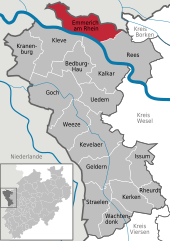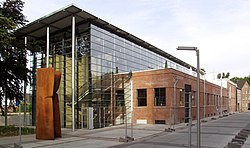
North Rhine-Westphalia or North-Rhine/Westphalia, commonly shortened to NRW, is a state (Land) in Western Germany. With more than 18 million inhabitants, it is the most populous state in Germany. Apart from the city-states, it is also the most densely populated state in Germany. Covering an area of 34,084 km2 (13,160 sq mi), it is the fourth-largest German state by size.
Kleve or Kreis Kleve is a Kreis in the Lower Rhine region of northwestern North Rhine-Westphalia, Germany. Neighbouring districts are Borken, Wesel, and Viersen in Germany, and the Dutch provinces of Limburg and Gelderland.
Viersen is a Kreis (district) in the west of North Rhine-Westphalia, Germany. Neighboring districts are Cleves, Wesel, district-free Krefeld, Neuss, district-free Mönchengladbach, Heinsberg and the Dutch province of Limburg.

Bocholt is a city in the north-west of North Rhine-Westphalia, Germany, part of the district Borken. It is situated 4 km south of the border with the Netherlands. Suderwick is part of Bocholt and is situated at the border annex to Dinxperlo.

Rees is a town in the district of Kleve in the state of North Rhine-Westphalia, Germany. It is located on the right bank of the Rhine, approximately 20 km east of Kleve. The population in 2005 was 22,559. Founded in 1228, Rees is the oldest town in the lower Rhine area.

Kerken with the towns of Aldekerk, Eyll, Nieukerk and Stenden, is a municipality in the district of Kleve in the state of North Rhine-Westphalia, Germany. It is located near the border with the Netherlands, approx. 15 km north-east of Venlo.

Kranenburg is a municipality in the district of Cleves in the state of North Rhine-Westphalia, Germany. It is located near the border with the Netherlands, 12 kilometres (7 mi) south-east of Nijmegen and 11 kilometres (7 mi) west of Cleves.

Alfter is a municipality in the Rhein-Sieg district, in North Rhine-Westphalia, Germany. It is situated approximately 6 km west of Bonn.

The Emmerich Rhine Bridge is a suspension bridge located in Emmerich am Rhein, Germany. Completed in 1965, it has a main span of 500 metres (1,600 ft), crossing the Rhine, carrying the Bundesstraße B 220, the federal highway between Emmerich am Rhein and Kleve. It is the longest suspension bridge in Germany.

At the end of World War II, plans were made in the Netherlands to annex German territory as compensation for the damages caused by the war. In October 1945, the Dutch state asked Germany for 25 billion guilders in reparations. In February 1945 it had already been established at the Yalta Conference that reparations would not be given in monetary form. The plan which was worked out in most detail was the one made by Frits Bakker Schut, and hence became known as the Bakker Schut Plan or Groot Nederland Plan.

Netterden is a village in the Dutch province of Gelderland. It is located in the municipality of Oude IJsselstreek, about 5 km northeast of Emmerich am Rhein in Germany.
Elten is a German village located in North Rhine-Westphalia. It has a population of around 4,500. Since 1975, it has been part of the town of Emmerich am Rhein. Between 1949 and 1963, Elten was part of the Netherlands. There is a substantial minority of Dutch citizens.
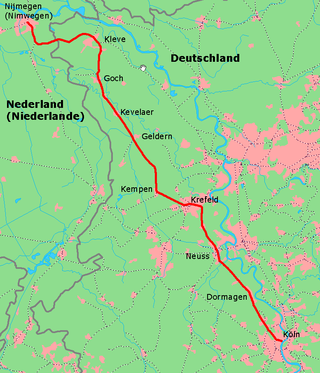
The Left Lower Rhine line is a main line on the left (western) bank of the Rhine in the lower Rhine region of the German state of North Rhine-Westphalia, running from Cologne to Cleves (Kleve) and formerly via Kranenburg to Nijmegen in the Netherlands. The Cologne–Krefeld section of the line was opened by the Cöln-Crefeld Railway Company in 1855 and is one of the oldest lines in Germany.
The Spyck–Welle train ferry was a train ferry on the Rhine between Spyck on the left (southern) bank and Welle on the right bank in the lower Rhine region of the German state of North Rhine-Westphalia. It was established in 1865 by the Rhenish Railway Company on the Lower Left Rhine line from Cologne to Neuss, Krefeld, Cleves, Elten, Zevenaar and the Dutch North Sea ports.
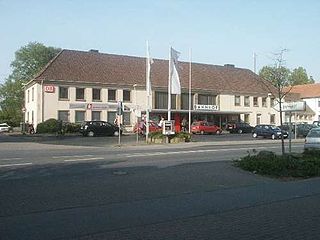
Emmerich is a railway station in Emmerich am Rhein, North Rhine-Westphalia, Germany.

The Rhein-Express is a Regional-Express service, which generally follows the Rhine river. It runs daily every hour from 5 am to 9 pm from Wesel via Oberhausen, Duisburg, Düsseldorf, Cologne, Bonn, Remagen and Andernach to Koblenz, in the German states of North Rhine-Westphalia and Rhineland-Palatinate. It is the fourth-most used regional express line in the VRR network with approximately 48,000 passengers a day.
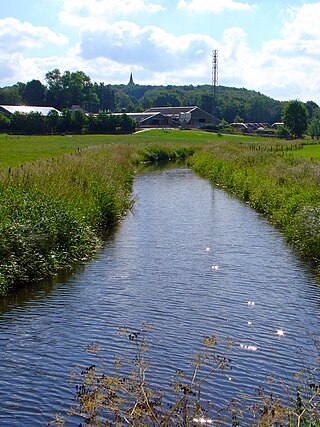
Die Wild is a small stream on the border between Germany and The Netherlands. It flows south of the Dutch town of 's-Heerenberg and the German village of Elten towards the north of the Dutch village of Spijk. North of Lobith it flows into the Oude Rijn, an old branch of the Rhine.

The County of Moers was a historical princely territory on the left bank of the Lower Rhine that included the towns of Moers and Krefeld as well as the surrounding villages and regions.

The Rhein-IJssel-Express is a Regional-Express service in German state of North Rhine-Westphalia and the Dutch province of Gelderland. It runs from Düsseldorf to Arnhem, with a section splitting at Wesel to serve Bocholt. VIAS operates the service on behalf of Verkehrsverbund Rhein-Ruhr (VRR).
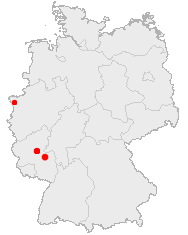
The Palatinate language island on the Lower Rhine is an area to the west of the Lower Rhine where since the mid-18th century a Rhenish Franconian dialect has been spoken, brought into the then-Prussian territory by settlers originating from the Palatinate region. Because the Protestants did not mix with the local Catholic population for a long time, their distinct dialect has remained partly preserved.

